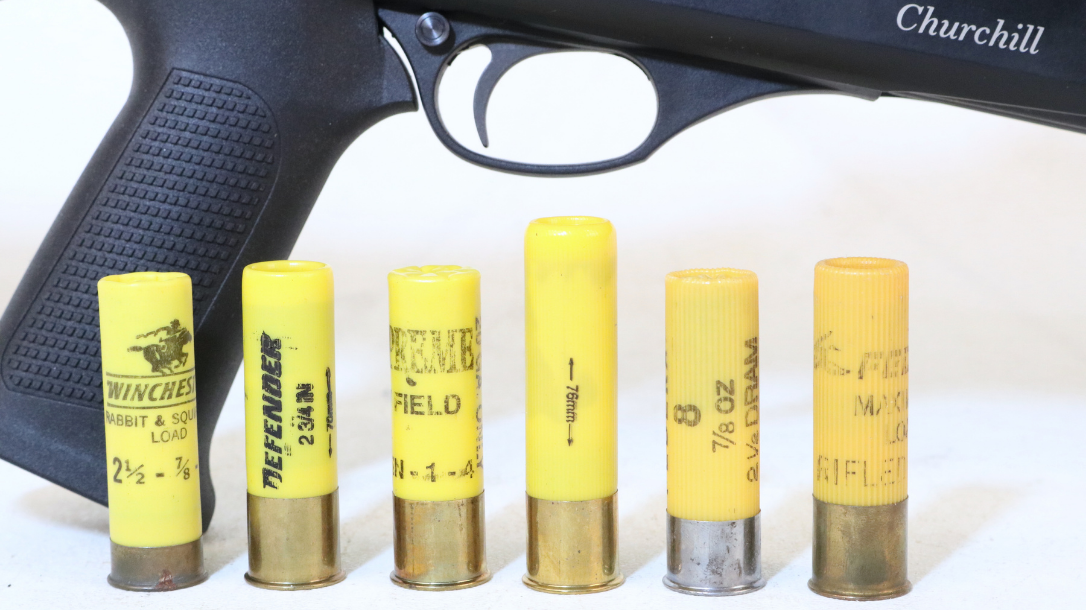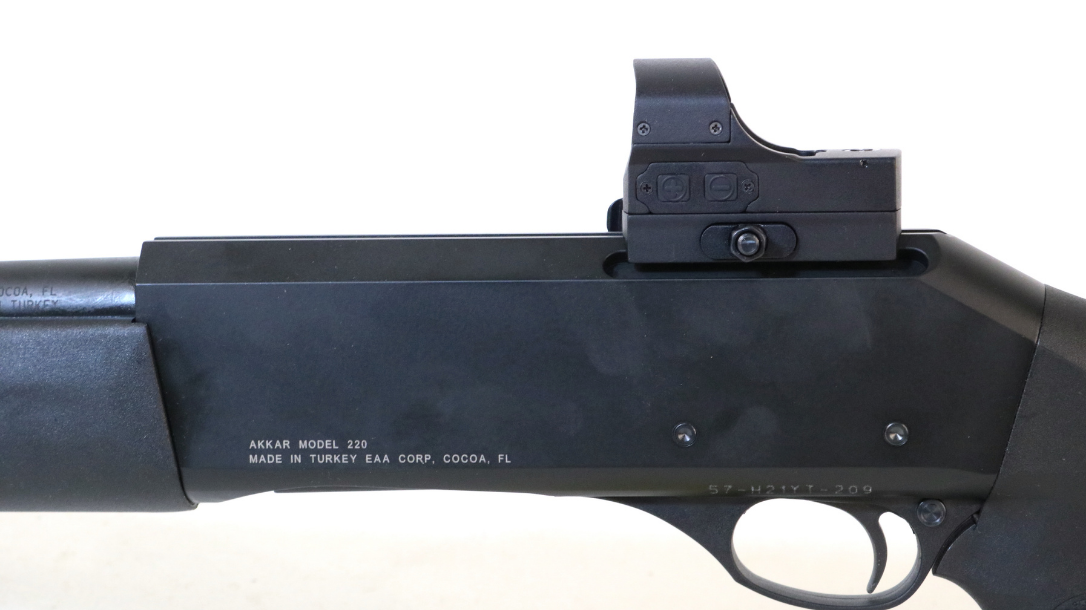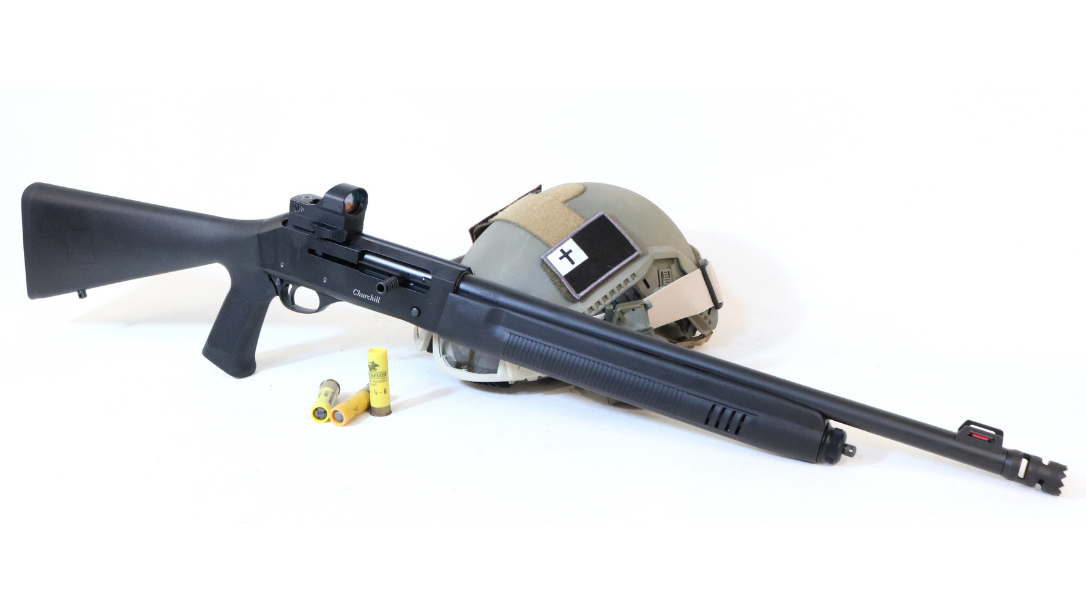The Churchill 220 Optics Tactical shotgun is a red dot-equipped, 20-gauge defensive shotgun from European American Armory that creates sensible firepower. The feature set is optimized for maneuverability and close-quarters power projection while the 20-gauge chambering keeps the chaos manageable. It is home defense without the kick.
Churchill 220 Optics Tactical Shotgun Basic Features
Featuring a 3-inch chamber and an 18.5-inch barrel topped off with a spiked breacher choke tube, the Churchill 200 Optics Tactical shotgun packs 5+1 onboard and weighs a paltry 5 pounds empty. The gas-operated, semiautomatic Churchill 220 Optics Tactical is designed for a single mission. This is the home-defense gun for the shooter who is comfortable with his or her masculinity.
I’m man enough to admit that I really don’t care for the 12-gauge shotgun. I’m kind of a skinny guy, and the immutable dicta of physics mandate that a lightweight 12-bore stoked with some proper defensive rounds will absolutely punish you. After a dozen or so high brass buckshot or slug rounds, my fun-meter is pegged. Fortunately, EAA has the answer.
Advertisement — Continue Reading Below
Origin Story
The term shotgun first appeared in print in 1776 in the prose of James Fenimore Cooper. Prior to that time, such a weapon would typically be known as a “fowling piece.” This presupposes a large-bore, muzzle-loading gun that fired shot rather than a single projectile.
The British Brown Bess musket sported a 0.75-inch bore diameter. That’s roughly the same size as a modern 10-gauge shotgun. It was not uncommon to load the Brown Bess with a buck-and-ball load that consisted of a combination of shot and a separate large-caliber musket ball.
The gauge system used to describe a shotgun bore is a curious English contrivance. The gauge is defined by the weight—in fractions of a pound—of a solid sphere of lead with a diameter equal to the inside diameter of the barrel. Put another way, shotgun gauge is the number of pure lead balls of a certain diameter that make up a pound. For instance, a 12-gauge has a bore diameter of 0.729 inches. Twelve lead balls of this particular diameter would weigh a pound.
Advertisement — Continue Reading Below
20 Gauge Might be The Way to Go

A 20-gauge shotgun has a bore diameter of 0.614 inches. This means that the humble 20-gauge still has a substantially larger bore diameter than that of a .50-caliber sniper rifle. The 20-gauge is indeed an underappreciated beast.
Lots of ammunition companies offer serious 20-gauge defensive rounds. Additionally, recoil in this loading is substantially more compassionate than might be the case with a 12-bore. In the proper platform this makes for some formidable capabilities.
Advertisement — Continue Reading Below
I have done my time in an urban emergency room. In close-quarters combat most any rifle beats most any handgun. At appropriate ranges most any shotgun will beat most any rifle. At bad breath ranges simple birdshot will carve a guy up like a gigantic ice cream scoop. The only thing more effective would include an impact fuse.
Churchill 220 Optics Tactical Shotgun Particulars
Everything about the Churchill 220 is optimized for defensive applications. The polymer furniture is just about indestructible, and the ample pistol grip stock offers a solid and comfortable shooting platform. The gun shoulders quickly and remains easy to control.
The semi-automatic action is easy to manage. The gun loads via a gate in the bottom of the receiver like most repeating scatterguns. The charging handle reciprocates with the bolt, so you can manually manipulate it in the event it gets sticky. The safety is the typical crossbolt pushbutton located just ahead of the trigger guard. A generously fenced, fiber-optic front sight offers quick acquisition in the absence of the red dot.
Advertisement — Continue Reading Below
The Churchill 220 Optics Tactical shotgun comes from the factory with an excellent red-dot sight and throw-lever mount. This full-sized optic features nice glass clarity, a 5-MOA red dot and an ample field-of-view. By running the gun with both eyes open you take advantage of the same situational awareness and rapid reaction capabilities found in a modern HUD-equipped fighter plane. HUD is mil-speak for Heads-Up Display. This is the way fighter pilots have been killing each other for generations now. Nowadays advances in microelectronics allow us to mount this same technology atop our small arms.
The Churchill 220 Optics Tactical features a lightweight yet rugged aluminum receiver and sling studs both front and rear. The gun’s dull, weather-resistant finish is both robust and cool-looking. The overall package brings more close-range thump than any rifle or pistol in a package that is actually fun to shoot.
Trigger Time
The Churchill 220 Optics Tactical just feels good in the hands. To charge the gun, feed five 20-gauge rounds in from the bottom, jack the bolt, and slip in one more. The bolt locks back automatically over an empty chamber. There is a right-sided pushbutton that drops the bolt on a fresh round.
Advertisement — Continue Reading Below
Slide-action shotguns look and sound cool, but that’s one more complex motor task to try to remember when somebody is actively attempting to kill you. With a properly-stoked Churchill 220 Optics Tactical shotgun you just point the thing at something you dislike, punch off the safety and squeeze. The action cycles way faster than I can. The downrange effects against soft targets, like milk jugs filled with water, are simply epic.
Red Dots on Shotguns are Fantastic

I love this red-dot sight on a shotgun. The gun moves fast and offers an enviable degree of precision. When throwing slugs, the Churchill 220 Optics Tactical shoots plenty straight at typical home-defense ranges. I like a nice, tuned sniper rig as much as the next rabid gun nerd, but there is no conceivable circumstance under which you might use a gun like that for real against a hostile bipedal adversary. A typical defensive engagement will invariably be up close and personal. In this battlespace the Churchill 220 Optics Tactical thrives.
Advertisement — Continue Reading Below
Buckshot offers unparalleled downrange thump. Furthermore, with the right load and right choke, it can be precise enough for low-percentage shots. Birdshot is unacceptable for home defense, as it lacks the ability to penetrate deep enough to rapidly incapacitate a determined attacker. Keep birdshot for the little birds.
Like most autoloading shotguns, the Churchill 220 prefers high brass slugs, buckshot and turkey loads. However, I left the bolt locked to the rear for a few days and it loosened up enough to cycle cheap birdshot as well. The gun just needs to be broken in a bit. At close ranges said birdshot will explode a water-filled milk jug like a hand grenade.
Final Thoughts
The options at your typical American gun emporium are ample, to say the least. Most folks pick a handgun for home defense, but the handgun is the toughest of all small arms in common use to run accurately and well. A tricked-out black rifle has undeniable merits. However, when there is something warm and precious sleeping on the other side of the drywall, I’d be extra careful where I tossed my high-velocity rifle rounds.
Advertisement — Continue Reading Below
A 12-gauge is a formidable tool, to be sure, but if the shooting experience is unpleasant that is a powerful disincentive to train. The argument could be made that the Churchill 220 Optics Tactical 20-gauge autoloading shotgun really is the ideal home defense tool. Easy to run, fast, powerful, thoroughly reliable with the right ammo, and mean, this optics-equipped room broom is comfortable, versatile and fun. The Churchill 220 Optics Tactical shotgun is the optimized defensive tool for the security-minded man or woman who doesn’t feel like he or she has anything ridiculous to prove. For more information, visit eaacorp.com.
SPECIFICATIONS: EAA Churchill 220 Optics Tactical Shotgun
- Gauge: 20, 3-inch chamber
- Barrel: 18.5 inches
- OA Length: 37.5 inches
- Weight: 5 pounds
- Stock: Synthetic
- Sights: Fiber-optic front/5-MOA red dot
- Action Gas-operated semi-auto
- Finish: Matte
- Capacity: 5+1
- Choke: Cylinder bore breacher-style
- MSRP: $627























